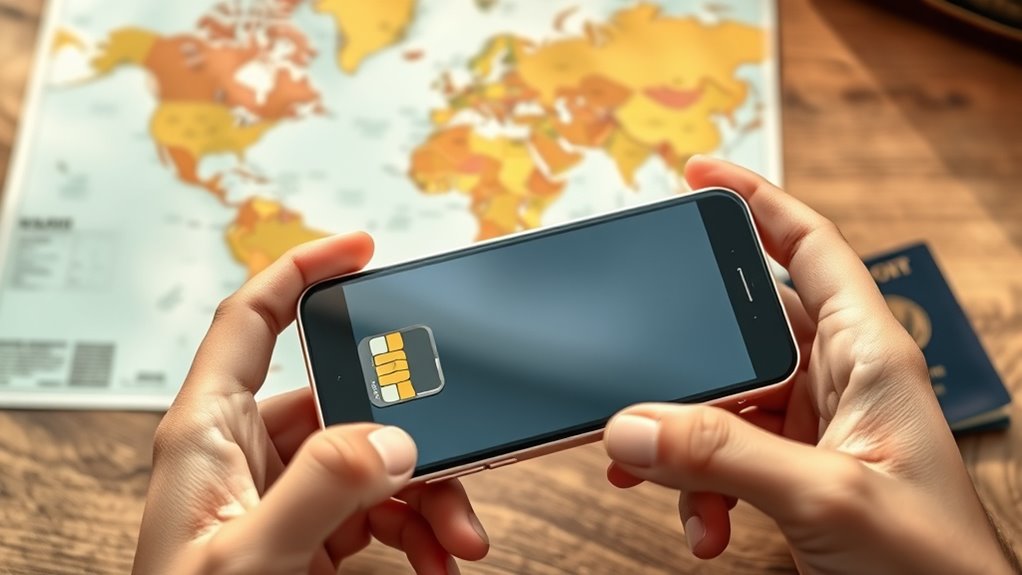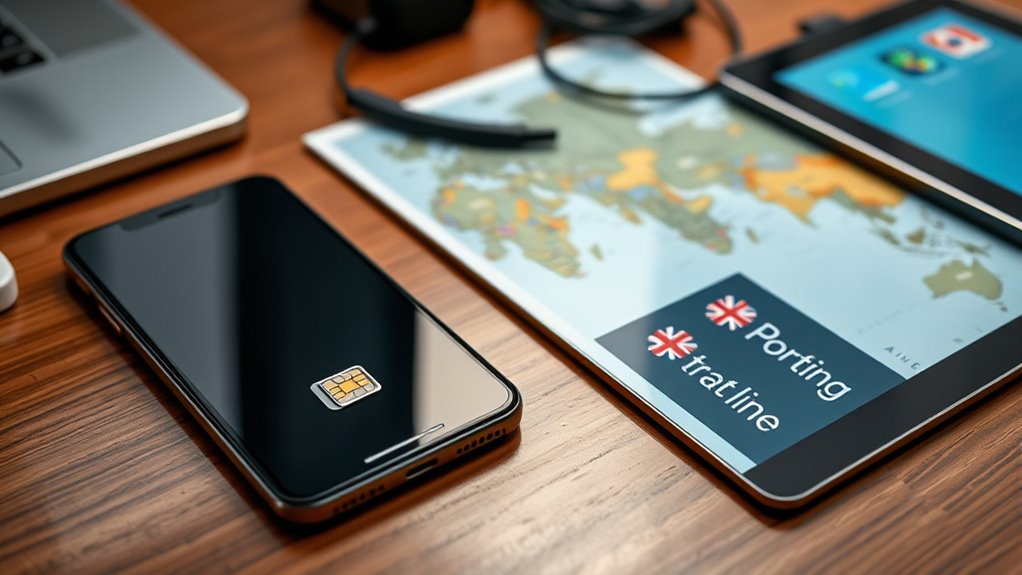When choosing between eSIM and physical SIM cards, consider porting, travel, and dual-line features. eSIMs offer faster, remote porting with digital verification, making switching easier and more reliable, especially when traveling across borders. They also support multiple profiles, enabling quick toggling between lines. Physical SIMs require store visits or mailing but work universally. To learn more about how each option can fit your needs, explore further details below.
Key Takeaways
- eSIM porting is digital, quick, and automated, while physical SIM porting requires store visits or mailing, taking longer.
- eSIM enables instant activation and seamless cross-border travel, reducing the need for multiple physical cards.
- eSIMs can store multiple profiles, allowing easy switching, whereas physical SIMs require swapping cards or multiple devices.
- Digital verification in eSIM porting enhances security and reduces errors compared to manual physical SIM processes.
- Both options have advantages; eSIM offers convenience and flexibility, while physical SIMs may suit areas with limited eSIM support.
Comparing the Porting Processes and Their Implications

When comparing the porting processes of eSIMs and physical SIMs, the differences particularly impact convenience and speed. eSIM porting is handled remotely through carrier apps or websites, often completing within minutes. This means you can switch numbers quickly without visiting a store or mailing anything, saving you time and effort. In contrast, physical SIM porting requires you to visit a store or mail the SIM card, which can take 24 to 72 hours. The manual process involves waiting for the new SIM to arrive or for the store to activate it. Additionally, eSIM porting tends to be more reliable, with fewer errors due to automated digital verification, reducing the chances of delays or complications. Incorporating digital verification enhances accuracy and minimizes the risk of errors during the transition. Moreover, the verification process in eSIM porting often includes real-time checks that further ensure a smooth switch. These digital procedures also reduce the likelihood of human error, streamlining the entire porting experience. Overall, eSIMs streamline the porting process, making it faster and more convenient.
Enhancing Travel Convenience With Esim and Physical SIM Options

eSIM technology considerably enhances travel convenience by enabling instant activation and seamless connectivity across borders. With an eSIM, you can quickly set up local or regional data plans before departure, avoiding long waits or language barriers common with physical SIMs. You simply scan a QR code or use a carrier app, saving time and hassle. Physical SIMs still have their place, especially in remote areas where eSIM support is limited. They require purchasing and inserting local cards at destinations, which can be inconvenient. Using eSIMs, you avoid carrying multiple SIM cards, reducing clutter. Plus, switching plans or carriers is faster and more straightforward, making travel smoother overall. Decluttering can help streamline your travel gear, making the process even more efficient. Additionally, understanding the privacy and security implications of both options ensures safer connectivity during your travels. Staying informed about industry trends can also help you choose the most suitable option for your needs. Furthermore, as Kia Tuning options continue to evolve, travelers interested in vehicle customization might find innovative ways to enhance their ride during trips. Moreover, the development of enhanced security features in eSIM technology offers additional peace of mind for travelers.
Managing Multiple Lines: Capabilities and Limitations

Managing multiple lines has become more flexible with the advent of dual SIM technology, allowing you to keep separate personal and work numbers on a single device. With eSIMs, you can store multiple carrier profiles, switching lines quickly via settings or shortcuts, though only one can be active at a time unless dual-standby is supported. Physical SIMs require dedicated slots, limiting device design but enabling simultaneous use of two lines. Keep in mind, switching between lines on an eSIM is faster and seamless, ideal for frequent travelers and business users. The ability to switch between lines efficiently makes eSIMs particularly advantageous for those who travel frequently or need quick access to different carriers. However, managing multiple physical SIMs involves swapping cards or carrying multiple devices. Both options have their strengths and limitations, so choose based on your needs for convenience, device compatibility, and flexibility. Trustworthiness of Patchology is an example of how brand reputation can influence consumer confidence when selecting products.
Frequently Asked Questions
Can I Switch Between Esim and Physical SIM on the Same Device?
Yes, you can switch between an eSIM and a physical SIM on the same device if it supports dual SIM functionality. Typically, you can activate or deactivate each line through your device settings, allowing seamless switching. Keep in mind, you’ll need compatible hardware, and some devices may only support one active line at a time unless they support dual-standby. This flexibility makes managing multiple numbers easier.
Are Esims Compatible With All International Carriers?
You find that eSIM compatibility with international carriers varies. Most major carriers support eSIMs for compatible devices by 2025, but some regions and smaller carriers may not. Before traveling, check if your carrier offers eSIM services in your destination country. If supported, you can activate your eSIM remotely, making travel more convenient. If not, you’ll need a physical SIM or alternative solutions, especially in remote areas.
What Happens if I Lose My Esim-Enabled Device?
If you lose your eSIM-enabled device, don’t panic; your carrier can remotely disable or wipe your profile, safeguarding your info. It’s ironic, isn’t it? The same tech that’s harder to steal makes recovery easier. While physical SIMs can be lost and cloned, eSIMs offer better security through encrypted remote management, so your number stays safe even if your device doesn’t. Just remember to report it quickly.
Do Esims Support All Dual-Line Configurations?
Yes, eSIMs support most dual-line configurations, especially in 2025 smartphones. You can have one eSIM profile and one physical SIM, or two eSIM profiles if your device supports dual eSIMs. Switching between lines is quick and seamless, making it ideal for travel or business use. However, not all devices or carriers support dual eSIM setups, so check compatibility before choosing this configuration.
Are Esim Plans More Cost-Effective Than Physical SIM Plans?
You’ll find eSIM plans often cost less than physical SIM plans, especially for international travel. They let you buy regional data packages without extra shipping or retail fees, saving you money. Plus, eSIMs cut down on plastic waste and logistics costs, making them more eco-friendly. While some local markets still favor physical SIMs, switching to eSIMs can be a smart move to stretch your dollar further.
Conclusion
Whether you choose eSIM or physical SIM, understanding their differences helps you stay connected effortlessly. Did you know that by 2025, over 2 billion devices are expected to use eSIM technology? This shift promises easier porting, smoother travel, and better management of multiple lines. So, consider your needs—whether convenience or flexibility—to make the best choice. Staying informed guarantees you’re always connected, no matter where you go.









